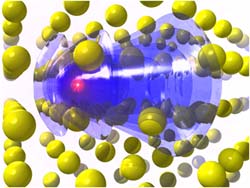Lawrence Livermore research identifies precise measurement of radiation damage

Model of the electronic wake (blue surfaces) generated by an energetic proton (red sphere) traveling in an aluminum crystal (yellow spheres). The resulting change in electronic density is responsible for modification of chemical bonds between the atoms and consequently for a change in their interactions. <br>
“A full understanding of the early stages of the radiation damage process provides knowledge and tools to manipulate them to our advantage,” said Alfredo Correa, a Lawrence Fellow from Lawrence Livermore National Laboratory in the Quantum Simulations Group.
Nuclear radiation leads to highly energetic ions that can penetrate large distances within matter, often leading to the accumulation of damage sites as the ions pass through the material.
During this process, the energetic ions eventually slow down as energy is lost by friction with the materials' electrons. Like a speedboat moving through a calm body of water, the passage of fast ions creates a disturbance in the electron density in the shape of a wake.
Correa along with colleagues Alfredo Caro from Los Alamos National Laboratory, Jorge Kohanoff from the the UK and Emilio Artacho and Daniel Sánchez-Portal from Spain, have directly simulated this quantum friction of the electrons in a real material for the very first time.
The team simulated the passage of a fast proton through crystalline aluminum. By accounting for the energy absorbed by the electrons and the magnitude of the impulse given to the aluminum atoms, the team was able to predict the rate at which the proton is stopped and the amount of momentum transferred. This is a precise atomistic simulation of the deposited energy and momentum, which is ultimately responsible for the damage that is produced in the material.
The new method opens up the possibility to predict the effect of radiation on a wide range of complex materials. The research not only applies to materials for nuclear applications, but also for materials related to the space industry, and new processing techniques for lasers and highly energetic ions. In biology and medicine, it also may contribute to understanding the effects of radiation on living tissues, both for damage and therapeutic processes.
In a broader sense, the new simulation capability represents the first step toward a unified method for the simultaneous simulation of electron and ion dynamics. The research is highlighted on the cover of the May 25 issue of Physical Review Letters.
More Information
“Nonadiabatic Forces in Ion-Solid Interactions: The Initial Stages of Radiation Damage,” Physical Review Letters, May 21, 2012
Quantum Simulations Group
“Simulating Materials for Nanostructural Designs,” Science & Technology Review, January/February 2006
“Helium rains inside Jovian planets,” LLNL news release, Jan. 26, 2009
Founded in 1952, Lawrence Livermore National Laboratory provides solutions to our nation's most important national security challenges through innovative science, engineering and technology. Lawrence Livermore National Laboratory is managed by Lawrence Livermore National Security, LLC for the U.S. Department of Energy's National Nuclear Security Administration.
Media Contact
More Information:
http://www.llnl.govAll latest news from the category: Health and Medicine
This subject area encompasses research and studies in the field of human medicine.
Among the wide-ranging list of topics covered here are anesthesiology, anatomy, surgery, human genetics, hygiene and environmental medicine, internal medicine, neurology, pharmacology, physiology, urology and dental medicine.
Newest articles

Webb captures top of iconic horsehead nebula in unprecedented detail
NASA’s James Webb Space Telescope has captured the sharpest infrared images to date of a zoomed-in portion of one of the most distinctive objects in our skies, the Horsehead Nebula….

Cost-effective, high-capacity, and cyclable lithium-ion battery cathodes
Charge-recharge cycling of lithium-superrich iron oxide, a cost-effective and high-capacity cathode for new-generation lithium-ion batteries, can be greatly improved by doping with readily available mineral elements. The energy capacity and…

Novel genetic plant regeneration approach
…without the application of phytohormones. Researchers develop a novel plant regeneration approach by modulating the expression of genes that control plant cell differentiation. For ages now, plants have been the…





















